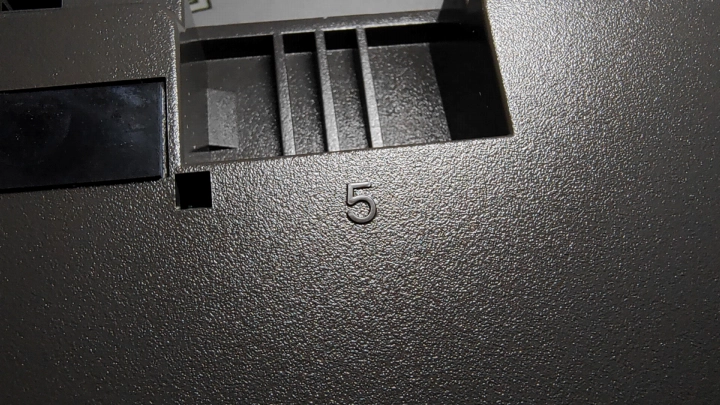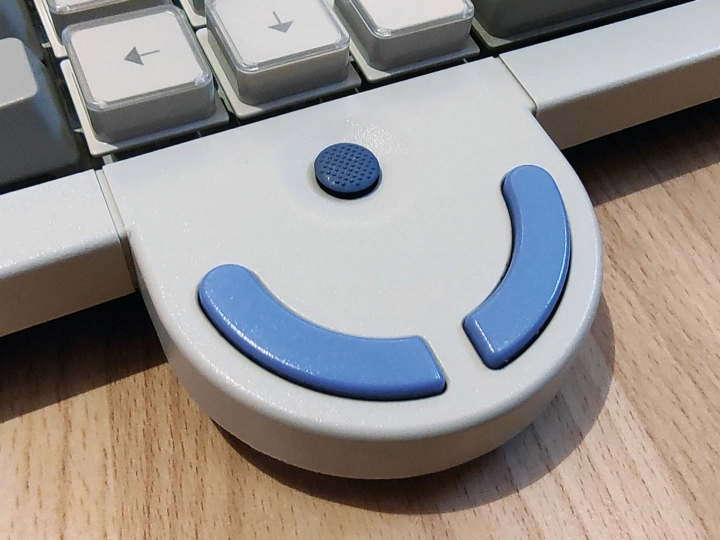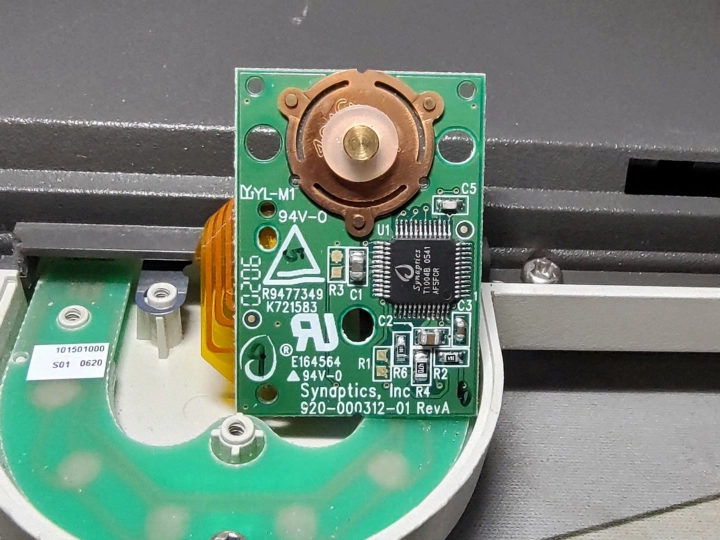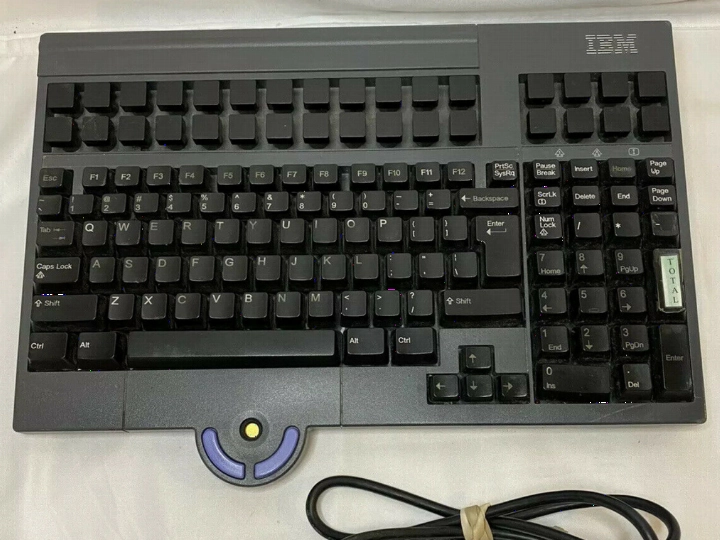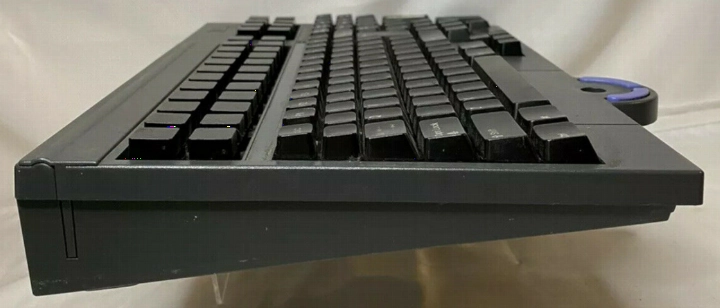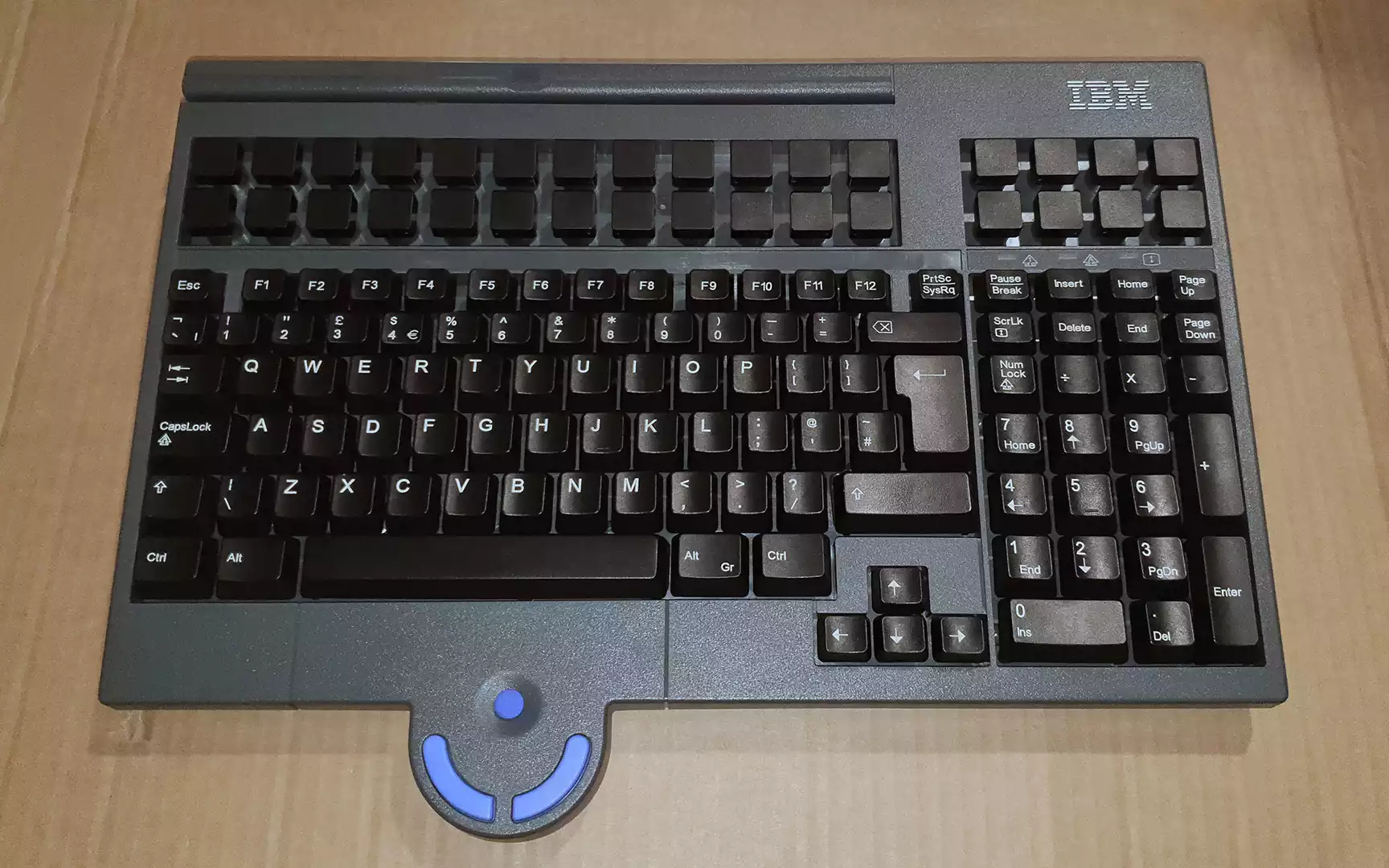Applies to IBM PS/2 ANPOS Keyboard with Integrated Pointing Device, IBM CANPOS Keyboard, IBM CANPOS Keyboard with Card Reader and IBM 4613 SurePOS 100 Keyboard Assembly
- Updated
Contents
Background
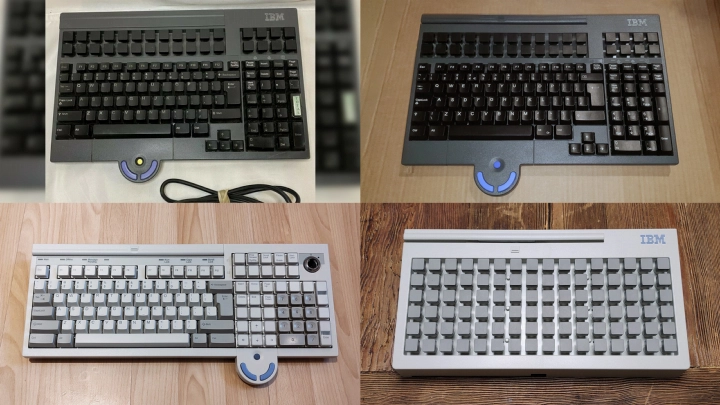
The IBM/Toshiba 'pre-Modular series' of POS (Pre-MPOS) input devices were an intermediate but not officially distinct series of POS keyboards using IBM buckling rubber sleeve key-switches that spanned the 2000s as various enhancements and follow-ups to Retail POS (RPOS) series but preceded the Modular POS (MPOS) series. All Pre-MPOS Model M-e keyboards were marketed as a supplement to RPOS rather than a replacement. These included adding pointing devices and compacting existing designs and filling in niches such as compacted alphanumeric keyboards and integrated keyboard assemblies. They are provisionally known in the enthusiast space as members of the Model M extended family ("Model M-e") due to their clear and pronounced lineage to the Models M7, M7-1, M8, M9 and M11 that make up the RPOS series. Pre-MPOS was introduced in 2001, a year after the Model M-e family was started with the introduction of the IBM 4820 SurePoint Monitor Keypad.
The Pre-MPOS series was relatively short-lived as after 8 years they were replaced by the namesake MPOS series that suceeded the two most notable keyboards in the Pre-MPOS series - the PS/2 ANPOS Keyboard and CANPOS Keyboard - leaving only niche devices. In 2012, IBM Retail Store Solutions was sold to Toshiba TEC[1] to become Toshiba Global Commerce Solutions (TGCS), which for a short while continued producing some Pre-MPOS designs. But like RPOS, Pre-MPOS was effectively obsolete during the TGCS era thus its believed production ended around 2015. Whilst the official Model M designation were dropped, these modern MPOS keyboards are evolutions of RPOS and Pre-MPOS keyboards and share much of their core DNA.

The Pre-MPOS keyboards retained the same IBM buckling rubber sleeves (known simply as [IBM] buckling sleeves) key-switches as the preceding RPOS keyboards. These were once IBM's primary portable computer key-switch technology in the first half of the 1990s, being adopted on famous IBM machines such as the IBM Personal System/2 L40SX (Model M3), IBM ThinkPads 700, 720, 750 and 755, and IBM RS/6000 Notebook 860 (Models M6 and M6-1). Unlike generic rubber dome key-switches, the rubber component in buckling sleeves plays no part in pressing down on the membrane. Instead, the design offloads this duty to rods on the keycaps or barrel-mounted sliders (depending on specific implementation) that descend through the keyboard's key-switch barrels. This effectively eliminates the mushy feeling of bottoming out on rubber dome keyboards since the actuation interface is more solid, whilst still keeping the design tactile and relatively quiet. IBM buckling sleeves are very snappy and quite tactile with what's perhaps best described as a medium stiffness feel relative to other key-switch designs.
The RPOS' adoption of buckling sleeves was presumably part of the reason they were designated "Model M" (M7 through M11), thus by extension why pre-MPOS keyboards are provisionally known as "M-e". All keyboards in this series use standard gauge sleeves with CANPOS additionally using medium-tall gauge sleeves for their half-height keys. The former sleeve gauge is interchangeable with all Model M3 and M4 and most Model M6 and M6-1 sleeves. The pre-MPOS' specific sleeves and actuation method implementation is known as the late (rod-actuated) POS-type IBM buckling sleevesn which were introduced in 2000 for the Model M-e 32-Key Monitor Keypad and later added to RPOS mid-way through production when their production was transferred from the Americas to Asia around 2002 to 2003. Before 2002, RPOS used what's known as early (barrel slider actuated) POS-type IBM buckling sleeves. Whilst pre-MPOS technically entered production before 2002, it is believed production was exclusively based in Asia thus pre-MPOS in fact introduced late POS-type IBM buckling sleeves. Most pre-MPOS sleeves are clear-translucent coloured and the only minute physical difference to the sleeves are slight grooves on their outer rims but this doesn't significantly alter the key-feel or sound. The later MPOS series continues using the same type of IBM buckling sleeves.
The PS/2 ANPOS and CANPOS Keyboards both sport two-button integrated pointing sticks (aka, "nubs") similar from an end-user perspective to the TrackPoint pointing sticks IBM used and Lenovo use on their ThinkPad laptops. They're usually referred to as "integrated pointing device" or simply "POS pointer" in marketing, but the actual technology is the force-sensing capacitor based Synaptics TouchStyk. The module used is identical to the design fitted in IBM/Lenovo SK-8835, SK-8840 & SK-8845 pointing stick & UltraNav keyboards.
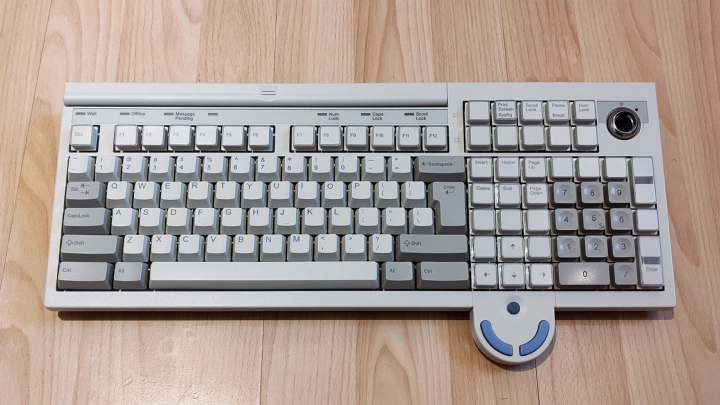
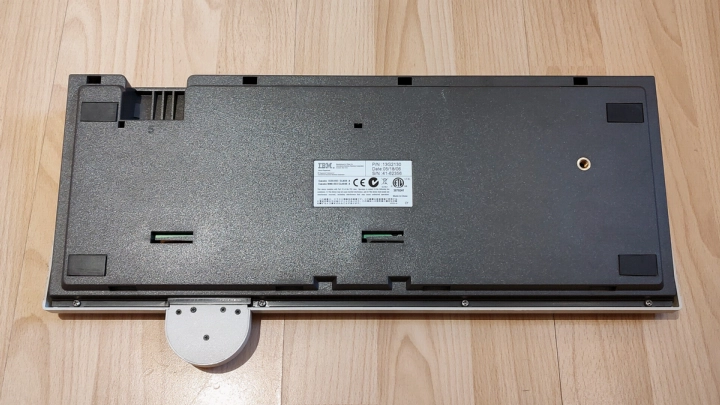
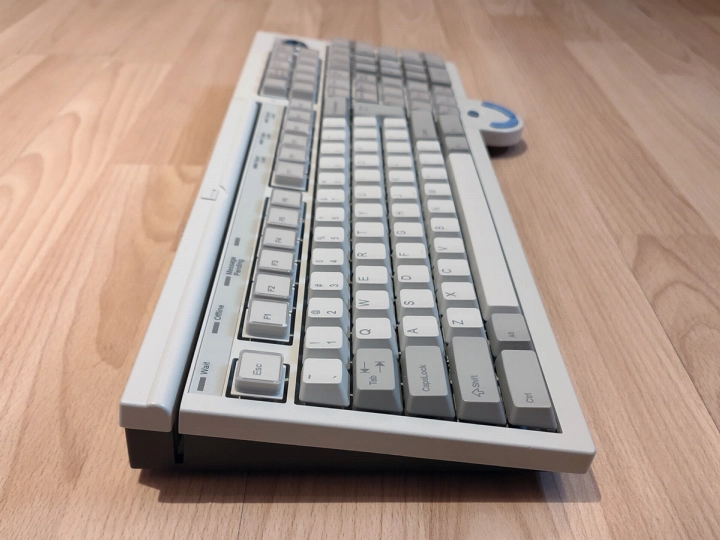
The IBM PS/2 ANPOS Keyboard with Integrated Pointing Device was a Model "M-e" enhancement of the original Model M9 RANPOS Keyboard design. It was introduced by February 2001 as that was the keyboard's first mention in the IBM Point of Sale Subsystem Installation, Keyboards, and Code Pages document[2]. By in large, it's the same keyboard design hence why it's occasionally referred to as the "M9-e" in fan circles, but a Synaptics TouchStyk based pointing stick and two mouse buttons are integrated within a new protrusion on the keyboard's bottom lip. Beyond that and namesake PS/2 connectivity, the keyboard features the same type of keys and integrated magnetic stripe reader as any M9 and was likewise available in 116-key (US English) and 117-key (rest of world) layouts. PS/2 ANPOS was succeeded by IBM Modular ANPOS (MANPOS, aka ANPOS II) Keyboard in 2008.
The IBM Compact ANPOS (CANPOS) Keyboard was one of two wholly new and most notable Pre-Modular "Model M-e" keyboard designs. CANPOS was developed by April 2002 as that is when version 1.0 of the IBM CANPOS Utilities appeared on IBM's public FTP server[%IBMFTPCANPOS%]. This version lacks an integrated magnetic stripe reader. CANPOS fits a full-size keyboard with many programmable keys in a chassis that is a similar width to a tenkeyless keyboard, making it an extremely featureful and flexible space-saving keyboard. Considering the arrow keys and numeric keypad placement, the design is somewhat reminiscent of the period IBM USB Keyboard with UltraNav (SK-8835) which could be considered CANPOS' server console and desktop PC counterpart. CANPOS has 133 (US English) or 134 (rest of world) keys although the alphanumeric keys are slightly thinner compared to M9 RANPOS, M-e PS/2 ANPOS and the later M-e MANPOS Keyboards. CANPOS lacked any sort of key lock but it still had a force-sensing capacitor based Synaptics TouchStyk pointing stick. CANPOS was replaced in 2008 by the IBM Modular CANPOS (MCANPOS, aka CANPOS II) Keyboard with a pointing module attached.
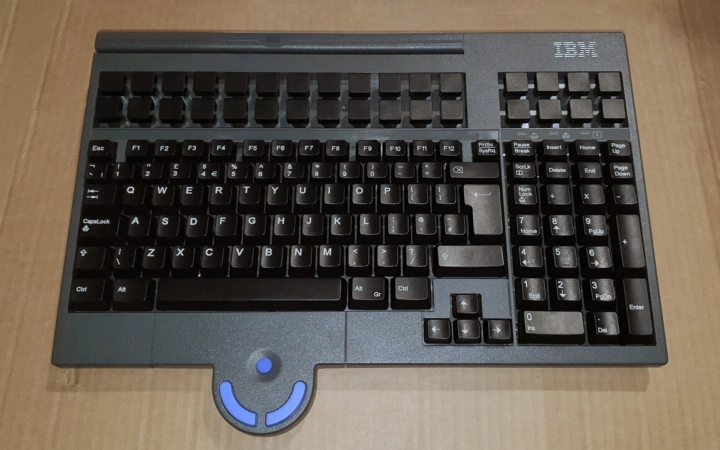
The IBM Compact ANPOS (CANPOS) Keyboard with Card Reader was one of two wholly new and most notable Pre-Modular "Model M-e" keyboard designs. It was introduced at the same time or later than the non-MSR CANPOS (April 2002). This version features an integrated magnetic stripe reader. CANPOS fits a full-size keyboard with many programmable keys in a chassis that is a similar width to a tenkeyless keyboard, making it an extremely featureful and flexible space-saving keyboard. Considering the arrow keys and numeric keypad placement, the design is somewhat reminiscent of the period IBM USB Keyboard with UltraNav (SK-8835) which could be considered CANPOS' server console and desktop PC counterpart. CANPOS has 133 (US English) or 134 (rest of world) keys although the alphanumeric keys are slightly thinner compared to M9 RANPOS, M-e PS/2 ANPOS and the later M-e MANPOS Keyboards. CANPOS lacked any sort of key lock but it still had a force-sensing capacitor based Synaptics TouchStyk pointing stick. CANPOS was replaced in 2008 by the IBM Modular CANPOS (MCANPOS, aka CANPOS II) Keyboard with a pointing module and MSR module attached.
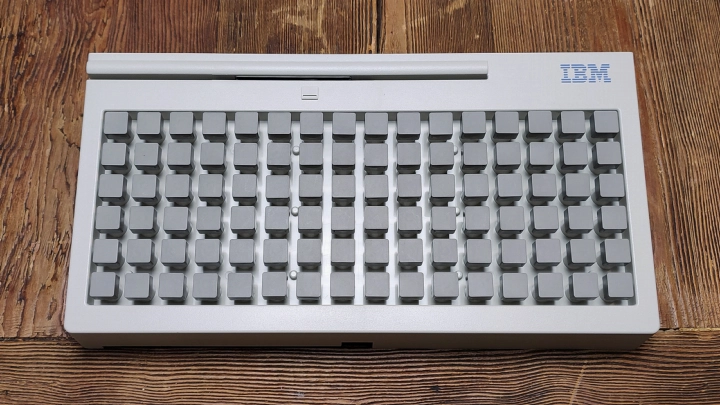
The IBM 4613 SurePOS 100 Express System was a compact all-in-one POS terminal introduced in 2008 that featured an integrated "Model M-e" based keyboard assembly. The keyboard itself resembles a shortened Model M11 Modifiable Layout Keyboard and in fact takes production values from late-era RPOS keyboards and sports an RPOS-style magnetic stripe reader. It has 96 keys in an ortholinear layout with both relegendable and alphanumeric setups known. It is considered to be the latest member of the Pre-MPOS series.
Internal
- IBM - Toshiba TEC to Acquire IBM’s Retail Store Point-of-Sale Solutions Business; Agreement Allows Both to Tap Growing Smarter Commerce Opportunity [accessed 2021-06-17].
- IBM - IBM Point of Sale Subsystem Installation, Keyboards, and Code Pages [accessed 2022-04-08].
